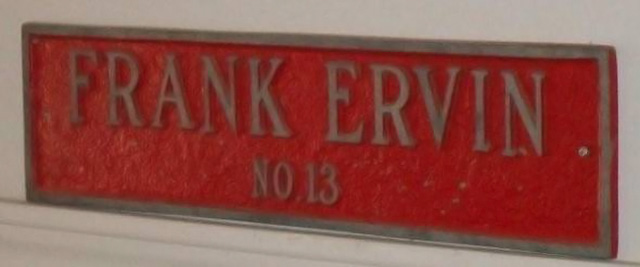SC Rewind: 1965 Little Brown Jug
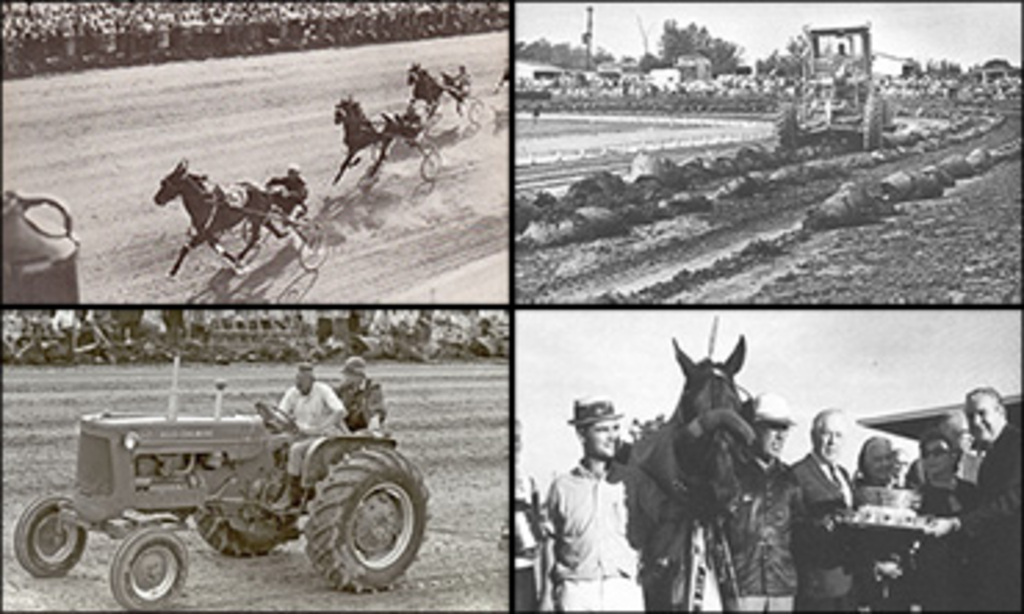
 In this week's edition of Rewind as we approach Little Brown Jug week, Robert Smith remembers the 1965 Jug and its famous winner Bret Hanover. This was just the 20th year of the famous race that has been held at the same place now for over 70 years. That year's race and the horse that won it remain as one of the most memorable in the race's long history.
In this week's edition of Rewind as we approach Little Brown Jug week, Robert Smith remembers the 1965 Jug and its famous winner Bret Hanover. This was just the 20th year of the famous race that has been held at the same place now for over 70 years. That year's race and the horse that won it remain as one of the most memorable in the race's long history.
From its very beginning 70 years ago in 1946, the Little Brown Jug has been a very special event year after year. Attempts have been made to categorize and rate each year's offering and try to label one or another as "The Best Ever." Probably a case could be made to bring out something special for nearly every one; it would be limited only by the ingenuity and resourcefulness of the author.
When LBJ Number Twenty was contested in 1965, it was a showcase of one of the sport's all time greatest performers, Bret Hanover. Unlike some years when rank outsiders have stolen the show, this fellow was known and loved by an entire Continent of harness followers and beyond. Despite the passage of a half century of time, new horses and more and more records, this horse continues to retain his popularity among fans old and new.
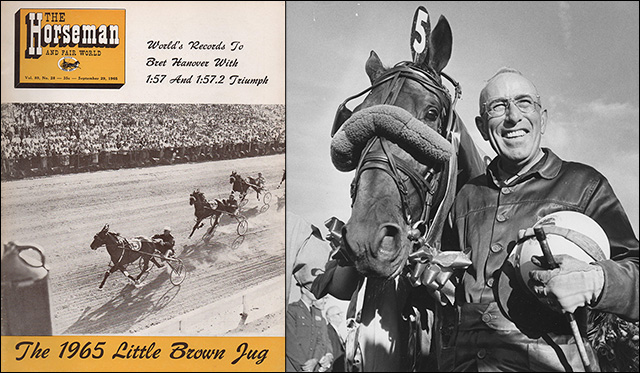
Left: The front cover of the Horseman and Fair World magazine shows Bret Hanover and driver Frank Ervin in command as they reach the wire at Delaware on September 23, 1965 to win that year's Little Brown Jug. The dust was blowing off the track despite the weather that closely preceded and almost cancelled the big event. Right: Bret Hanover and his very happy trainer-driver, 61-year-old Frank Ervin enjoy the day after winning both heats of the 1965 Little Brown Jug at the Delaware County Fairgrounds (U.S.T.A. Photo)
The 1965 Jug may well be recalled as the race that almost didn't happen. Thanks to torrential rains that started the previous afternoon, the Delaware Fairgrounds and particularly the racing strip was a virtual quagmire. Few of those in charge, let alone almost everyone else on the planet, believed that there was a chance that the big race could ever go off as scheduled. As late as 9:30 a.m. on race day the 'odds' were slanted steeply against the possibility of holding the Jug. The heavens were still weeping profusely, but the forecast for what it was worth did state "partial clearing."
Wayne "Curly" Smart the track superintendent (the same man who won the inaugural Jug in 1946) was up early and spent an anxious start to his day. He was not only charged with maintaining the track and keeping it in razor sharp condition, he also had a horse to drive in the Jug by the name of Tuxedo Hanover and they were anything but throw-ins to fill out the field. Long before the rain finally stopped he and many others were out driving around the track in Jeeps and tractors; all probing the surface to see just how deep the mud had become. It seemed all eyes were on Mr. Smart and his aim was to please as many people as he could. Opinions and helpful advice varied from "no possible way" to "hope for a break and race it today."
By about 10:00 a.m., Mr. Richard Downing, owner of Bret Hanover arrived at the Delaware oval. He quickly made his way to the Ervin barn where he was met with a dismal greeting from his trainer. About the most optimistic statement he could come up with was to say "Well it hasn't been officially cancelled, at least not yet!" Somehow at about the time of Mr. Downing's arrival, with him came a stop in the rain and soon a few wisps of brighter light appeared in the fall sky.
As the officials again convened on the track it was evident that a final decision had to be made quickly if the day was to be salvaged. The two most prominent in the 'huddle' were Mr. Smart and Hank Thomson, the Jug Society President. By now it was mid-morning and despite the weather people were starting to arrive.
After much thought by both men, Mr. Thomson said in a fairly loud voice "What's your verdict, Curly?" To which he answered "Call in the County equipment and we'll skin it; I think we can race today." From that moment on what quickly and lastingly became known as 'The Miracle Of Delaware' began. Smart gathered his associates together and soon they all headed off in different directions, but all with the same plan in mind. Wray Byus, Lee Watson, Ted Ketcham, Jim Nolan and a host of others soon appeared with about every machine and earth moving device they could find. It was as if magic was in the air.
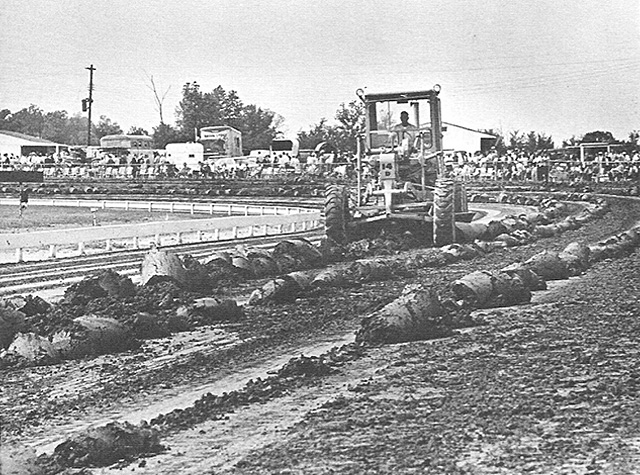
Often termed "The Miracle Of Delaware" this photo shows how the track was completely reworked by heavy construction type equipment in order to make it raceable for that year's Jug.
Soon the weather decided to cooperate and the huge task of scraping the track began. At noon an announcement was made that the first post time would be delayed for one hour. It seemed that not a soul in attendance was upset in the least. One slightly negative aspect began to be discussed and that was just how many seconds "off" the track might be. Obvious to all was that Overtrick's world standards of 1:57.1 for a single heat and 3:54.4 for two heats set in 1963 were safe. Perhaps the trade off of seeing Bret Hanover and Adios Vic was still well worth the price of admission. A record crowd of 41,200 came to see history in the making, although it may not have been evident at the time.
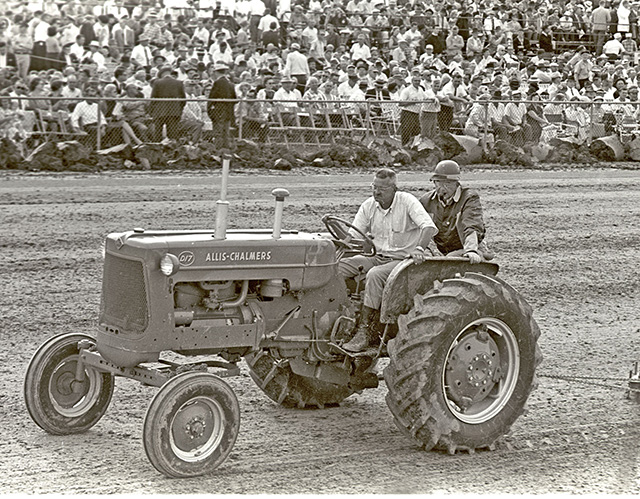
A tractor works on the Delaware oval in preparation for the 1965 Little Brown Jug. Standing on the back of the tractor wearing his racing silks is horseman Wayne "Curly" Smart who also served as Track Superintendent. In addition to his duties of preparing the track he was also driving one of that year's contenders Tuxedo Hanover. Smart did the impossible in readying the track and also finished second in both heats. (U.S.T.A. photo)
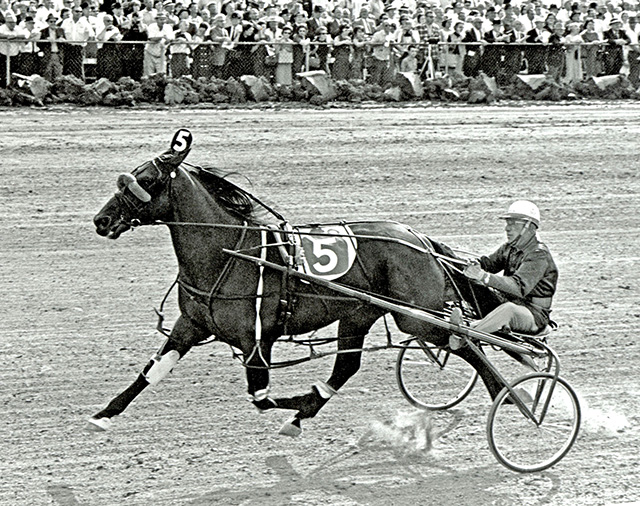
Bret Hanover and Frank Ervin score in front of the huge crowd assembled to watch history in the making. Visible in the background are the large rolls of earth that had just been scraped from the track's surface. (U.S.T.A. photo)
Four hours after Mr. Smart had announced his decision, the seven entrants for the 1965 Little Brown Jug answered the bugle call and paraded onto the track. A day and a race that a few short hours earlier seemed impossible was now underway. Frank Ervin and Bret Hanover had a plan in mind and to the surprise of no one, they were interested in one spot on the track and that was on the lead. One person who had other ideas was the driver of Skipper Gene, young Fred Cheney, a local Ohio boy. He left like a 'house on fire' and was still on top at the quarter in :28.4; Bret and Ervin were fourth on the outside, not exactly how it was written in the game plan.
As the field reached the half, the upstart Skipper Gene was still on the lead and no one was more surprised that Frank Ervin to catch the time of 58 seconds flat that flashed as they passed the timer. Here the mystery of the race began to become more like the plan and as the horses entered the first turn on the second time around, Ervin hustled his mount past the inside horses and took the lead. Bret Hanover paced on from here basically without urging or effort and about the only concern was when would Adios Vic challenge, which he did not. Instead Tuxedo Hanover and the 'man of the hour' Curly Smart was his closest pursuer, some 3-1/2 lengths back. As the horses hit the wire and announcer Stan Bergstein shouted out the time of 1:57 flat, the crowd went wild.
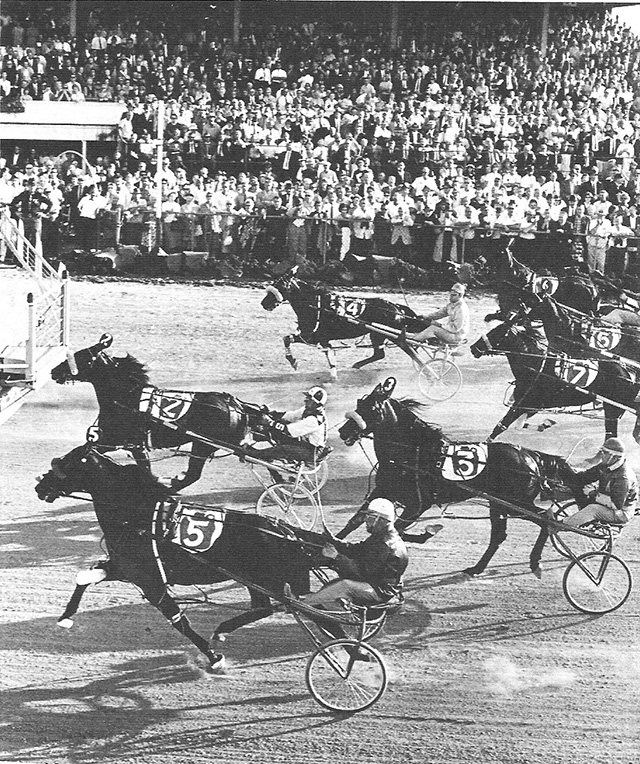
The horses line up behind the gate for the second and final heat with number 5 Bret Hanover, no.3 Tuxedo Hanover (Smart) and no. 2 Rivaltime with George Sholty. The customary huge crowd can be seen in the background.
After an hour's rest, the second and concluding heat was contested. Bret trailed Rivaltime and George Sholty to the quarter and then quickly took the lead and sailed home in 1:57.2. Again Adios Vic was not a factor as he found the shorter turns not to his liking. Tuxedo Hanover again took aim at Bret, keeping him honest but was two lengths in arrears at the wire.
The two record-breaking miles erased Overtrick's name from every category in the record books. In the short space of a couple of hours Bret Hanover set six world records and further endeared himself to a nation of adoring fans.
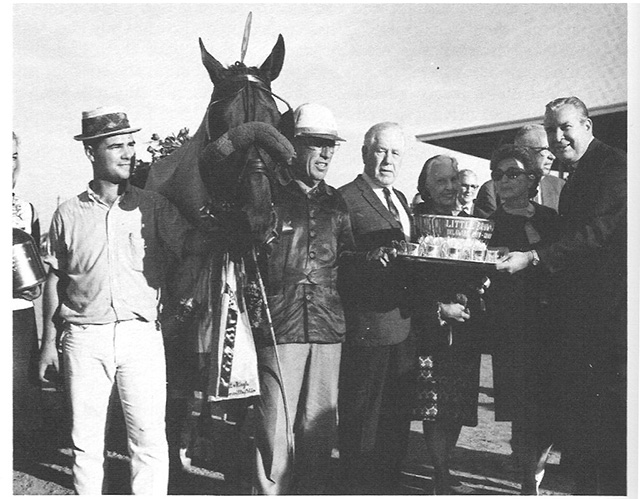
The Delaware winner's circle is a happy place with Bret Hanover in the middle. From left are Dave Willoughby, groom; Frank Ervin; Mr. And Mrs Thurman Downing, owners; Elizabeth Ervin; and Ohio Governor James Rhodes presenting the winning silverware.
The famed harness writer Donald P. Evans wrote "It can't be found in any record book, but still another mark was set in the 1965 Little Brown Jug. The greatest volume of applause ever accorded a horse and driver who finished second in a race. That honor fell to Tuxedo Hanover and Curly Smart as they returned to formally salute the judges at the conclusion of the second heat." The man had turned a bog into a world record race course and the appreciative crowd wanted to thank him.
The entire story of Bret Hanover and his trainer and driver Frank Ervin, who at the time was certainly in the twilight of his career at the age of 62, is a fascinating and timeless story. He was selected by Mr. Ervin as a yearling purchase for his only owner while racing, Mr. Richard Downing of Shaker Heights, Ohio. His purchase price at auction was $50,000, the highest paid in the 1963 sale year. He went undefeated as a two-year-old in 24 starts. At three he won 21 of 24 starts, winning 35 straight races before tasting defeat by his chief rival Adios Vic. He was retired from racing at the end of his four-year-old season after winning 17 of his 20 starts that season. He retired as the sport's richest and fastest pacer with earnings of $922,616 from 68 lifetime starts in which he finished 62-5-1. Following a tremendously successful career in the stud, Bret Hanover died at the age of 30 in 1992.
Around 1986, I had the pleasure of an afternoon long visit with Frank and Elizabeth Ervin at their beautiful home in Orlando, Florida. By that time, unfortunately, Mr. Ervin had suffered a serious stroke that left him with limited mobility and greatly compromised his speaking ability. Despite all of this, he was extremely helpful and with his wife's assistance at times, he took me back through his long and interesting career. It was a special day for me and I was fortunate to later have a story published in the February 1987 edition of Hoof Beats titled "A Visit With Frank Ervin." I also have reason to often think of this great horseman as I have a stall marker from his famous stable mounted on my garage wall. Barely a day goes by that I do not take a look at it as I pass by.
